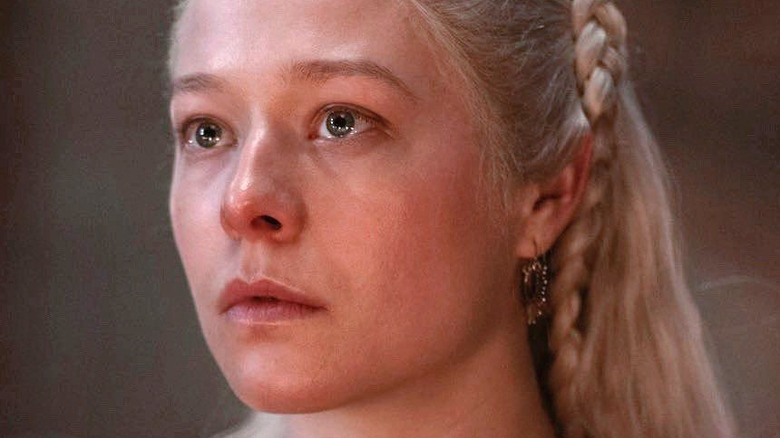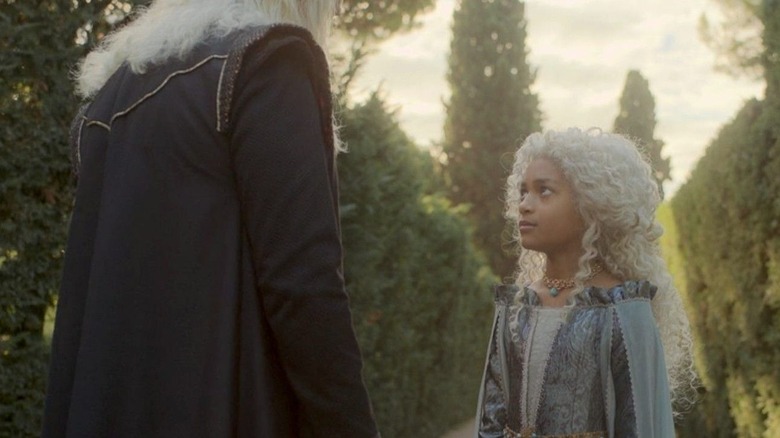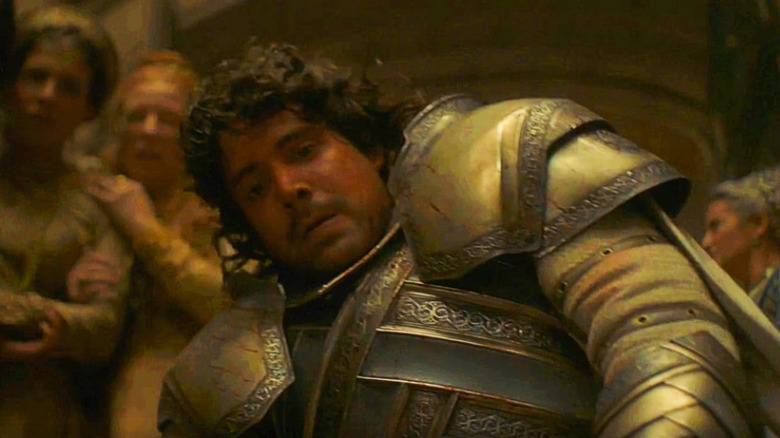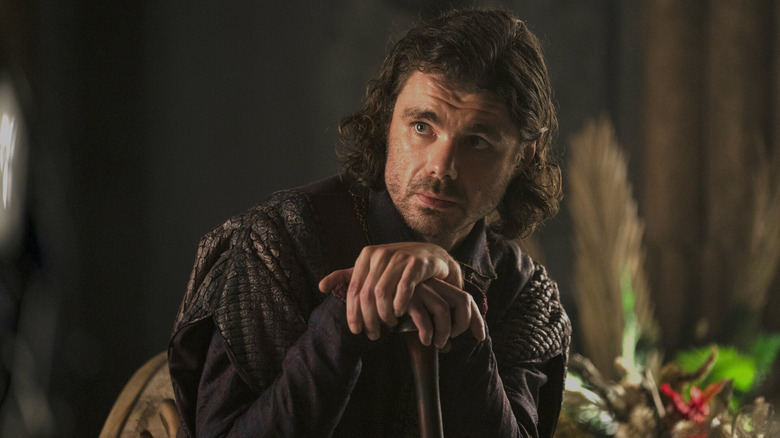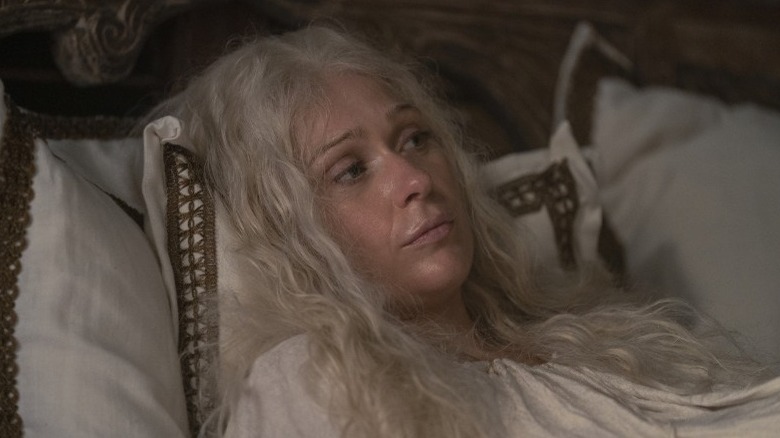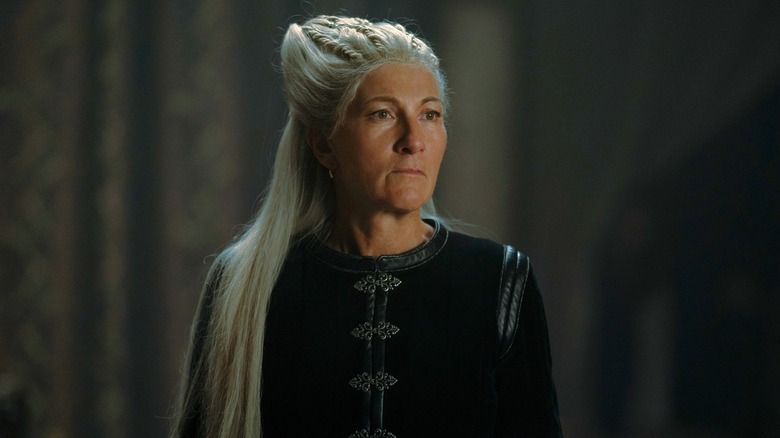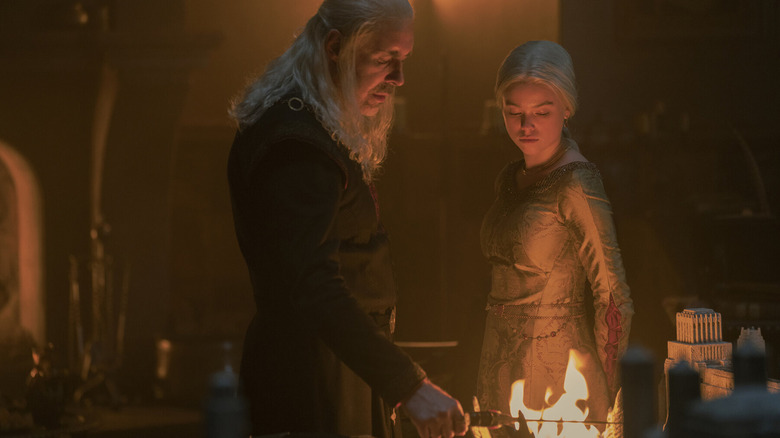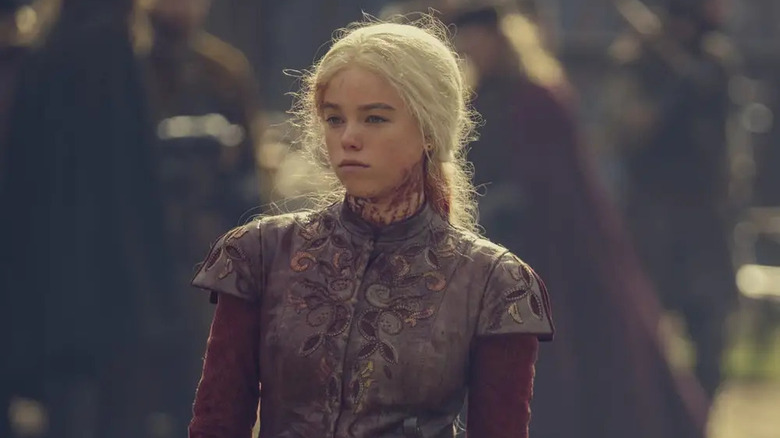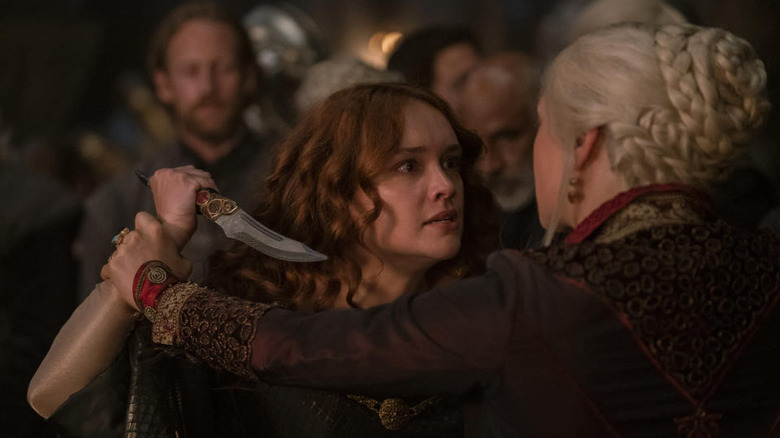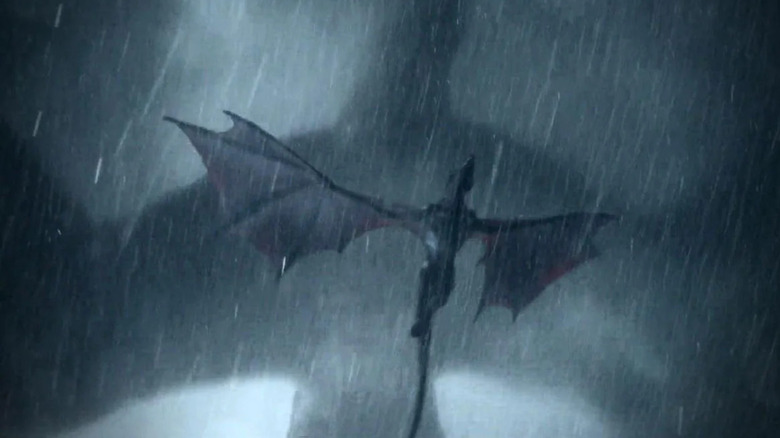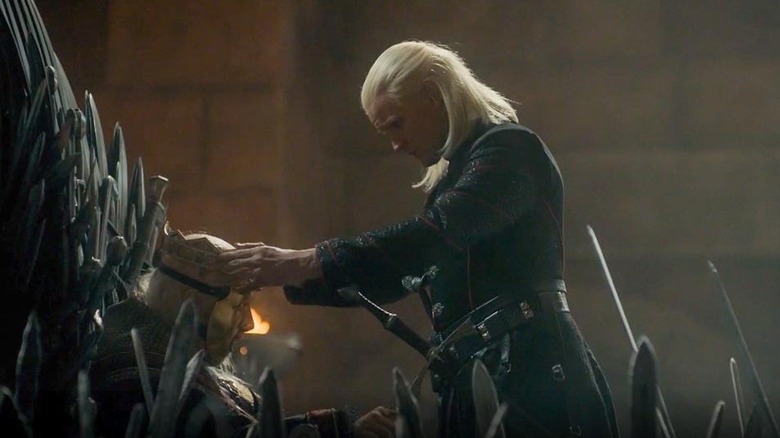Every Episode Of House Of The Dragon Season 1 Ranked
Fans of the "Game of Thrones" universe have had their patience and loyalty tested over the last few years. Readers have waited since 2011 for the next installment of George R.R. Martin's "A Song of Ice and Fire" series. Without a sixth and seventh volume to work from, "Thrones" showrunners Weiss and Benioff produced a finale season that frustrated some viewers who'd made the series appointment television. The situation was so dire, the fandom all but went dormant following the conclusion of a disappointing Season 8.
HBO attempted to recapture the Westerosi magic with a planned prequel series starring Naomi Watts, but that project failed to make it past the pilot stage. "House of the Dragon," a second prequel concept based on the first volume of Martin's Targaryen history, "Fire & Blood," debuted on the network more than three years after the last episode of "Thrones" aired.
To everyone's surprise and delight, the new show has succeeded where late seasons of "Thrones" and the canceled series could not. Fans are tuning back in huge numbers and they're generally happy with what they're seeing. With #houseofthedragon and #HotD regularly trending on Twitter, Martin's world has become the subject of the digital watercooler again. Fans are back to meme-ing memorable moments, hating on villains, and rooting for their choice to win the Iron Throne. Despite significant challenges including several time jumps that required dual and triple castings, Season 1 of "House of the Dragon" was a hit. But, as is the case with dragons themselves, some soar higher and pack more power than others. Though all 10 have their merits, these are how Season 1 of "House of the Dragon's" episodes rank, from worst to best.
10. Episode 2 - The Rogue Prince
There isn't a bad episode in the first season of "House of the Dragon," and since (with the exception of Episodes 9 and 10) the show switches back and forth between so many sets of characters, it's probably more accurate to say there are storylines or parts of the main storyline that were of more interest to audiences. Episode 2, "The Rogue Prince," can boast one incredible visual sequence. Caraxes and Daemon square off against Otto Hightower, Rhaenyra, and Syrax on Dragonstone's parapet over the matter of the stolen dragon egg. We aren't that invested in this subplot, but it sure is magnificent to look at.
Elsewhere in Episode 2, Viserys has a date with 12-year-old Laena Velaryon, which is probably what "The Rogue Prince" will be remembered for more so than anything involving the actual Rogue Prince himself. A teenage Rhaenyra looks on and listens in as the adults around her discuss the need to replace her mother as soon as possible. This puts the otherwise likable Corlys and Rhaenys in the uncomfortable position of having to coach their tween as to what to say to the king when the subjects of menstruation and sex come up. It also leads to a completely non-sugarcoated conversation between the Queen Who Never Was, Rhaenys, and the queen who's supposed to be, Rhaenyra, in which the former basically tells the latter not to get her hopes up. The episode ends as Viserys announces he'll marry Alicent, but most of the runtime is connective tissue between more interesting plot points.
9. Episode 5 - We Light the Way
Fans were already bracing for Episode 5, "We Light the Way," to be a heartbreaker since it was the last one that would star Milly Alcock as young Rhaenyra and Emily Carey as young Alicent. Then, just when viewers were enjoying what seemed like a relatively smooth Westeros wedding, the seven hells broke loose.
Had the show stuck to the books, this hour would've been about Alicent and the king's anniversary instead, and it would've given us the long-awaited black dress-green dress showdown that we never really got. In theory, this episode was meant to belong to Alicent Hightower and that green dress. It's named after her house words, and the still of the queen in her call-to-arms gown is instantly memorable.
But in practice, Criston Cole steals her thunder. It's his episode, or at least he's in most of it. He reveals his true colors when he tries and fails to convince the princess to run away with him to Essos after their one-night stand. He stupidly admits to breaking his oath, then he completely loses his cool and brutally murders the protector and lover of the son of one of Westeros' richest and most important families, not to mention the king consort-to-be. Either feeling shame or fearing repercussions, Criston nearly kills himself before Alicent stops him and wins him to the Greens' side. "We Light the Way" features a few intriguing moments prior to the violence (Daemon and Rhaenyra's dancefloor chat in High Valyrian among them), but overall, it's too much of the loathsome Ser Criston to easily stomach.
8. Episode 6 - The Princess and the Queen
Just as fans were nervous about saying goodbye to two actors they'd grown to love, they were nervous about saying hello to the two actors about to fill their roles. Emma D'Arcy and Olivia Cooke were absolutely up the task. The second half of the season is arguably stronger than the first, but "The Princess and the Queen" is the least appealing of the post-time jump episodes.
Episode 6 does several things well. It convincingly handles the passage of ten years and shows how much the friendship between the former friends has deteriorated. But much of the business it has to attend to is, well, unpleasant. It begins with the very audible birth of Rhaenyra's third son, Joffrey, followed by her grueling trek to Alicent's quarters, where she and Laenor are roundly mocked for the state of their marriage. Criston's still awful. Teenage Aegon might be worse. We're subjected to an awkward scene in which his mom interrupts his depraved window activities only to emotionally abuse her still-naked son about her ambitions for him to rule.
But the worst part about Episode 6 is that we don't get to see much of Daemon and Laena or Rhaenyra and Harwin's relationships. They (along with the ever-respectable Lyonel Strong) die by fire before they've exchanged more than a few words and hardly any affection. Instead, we see Larys cut the tongues from criminals then (nonsensically) outfit his assassins with sigil of a firebug that he's invented for himself. Season 1 covers about 30 years if you count the prologue, but this is the only episode that feels like it moves way too fast.
7. Episode 1 - The Heirs of the Dragon
Already, we're getting to the point where it's difficult to find much fault with "House of the Dragon." If the pilot hadn't been as effective as it was, fans wouldn't have invested in the show so quickly. Episode 1, "The Heirs of the Dragon," is beautifully structured. It opens with a foreboding prologue that sets up the stakes. It ends with a revelation that surprised everyone and added to "Thrones" lore. And in the middle, there's a harrowing crosscut between the king's ill-advised tournament and Aemma's doomed labor. It's genuinely exciting to see King's Landing at its peak, and with knights and dragons back on our small screens, what's there to complain about?
Some fans disliked how graphically Aemma's death was depicted. Others wondered whether a tourney would've gotten quite that violent. But "The Heirs of the Dragon" did what it had to do, for book readers and show-only audiences alike. For the familiar, the episode brings to life key moments and dynamics from "Fire & Blood," such as Daemon's stint as the Captain of the City Watch. For those just acquainting themselves with this generation of Targaryens, it quickly establishes Rhaenyra, Alicent, Viserys, Daemon, Otto, Corlys, and Rhaenys as people we want to follow, even if we love and hate them to wildly varying extents. And when the king names his daughter as his heir, we get a whopper of an inciting incident to what will become a much more intense series. The pilot's main challenge is it has to do the work of half a book's worth of exposition, and it more than overcomes it.
6. Episode 9 - The Green Council
The last two episodes of Season 1 function like a two-part finale. Episode 9, "The Green Council," had the slight misfortune of airing first, which — as we just noted regarding the pilot — means it has to do more setup than payoff. It's also entirely about the Greens (save Rhaenys), who (let's be honest) are less popular with fans than the Blacks, as they're the ones who usurp the Throne in this very episode.
"The Green Council" includes a few scenes that bothered viewers. The race to find Aegon isn't of much consequence. The way Larys exploits Alicent is upsetting. And though the climax gives Meleys the Red Queen her moment in the spotlight, it's mystifying that Rhaenys would kill so many commoners but spare the Greens.
But Episode 9 also contains some of the show's best moments. The scene in the small council room after the king's death is more tense than any of the series' battle scenes thus far. Aegon II's coronation is a gorgeous yet terrifying representation of the dawning of fascism and the public's apathy toward it. And Eve Best and Olivia Cooke deliver two of the series' strongest performances to date. Alicent believes she can convince Rhaenys, who has no love for Rhaenyra, to turn. The soon-to-be Dowager Queen plays the role of a reasonable politician well enough, but as the savvy princess points out in a devastating blow to her expectations, Alicent is still serving and ceding power to men.
5. Episode 4 - King of the Narrow Sea
So far, "House of the Dragon" hasn't been quite as racy as "Game of Thrones" was, especially in its earlier seasons. Some of that is on purpose. Still, a boundary-pushing Episode 4 got hearts a-fluttering, and audiences weren't sure how to feel about it. This is the episode which begins with Daemon being accepted back into the family after surrendering his crown and ends with him being banished again after cynically corrupting his niece. That makes for a neat arc within an anything-but-neat story that unfolds in between points A and Z.
"House of the Dragon" telegraphs how Rhaenyra feels about Daemon from the second he clasps that pendant around her neck. The Rogue Prince doesn't have to do much persuading to get her into peasant garb and out of her room. Their hour of the owl escape is one of the only times we leave palace walls this season. The lewd play and the blind woman who can foresee deaths are nice touches, but the real action takes place at the pleasure houses on the Street of Silk. Rhaenyra isn't scandalized; Daemon's trick (he definitely wanted to get caught) became her sexual awakening. He left her cold, but she learned an important lesson (one she immediately tries out on Ser Criston, in the last minutes in which we like him). While Alicent is a prisoner in her marriage, Rhaenyra decides not to be.
What's more, her dad is pretty chill about it. He acknowledges the double standard women face, and sends her some Plan Tea, but she gets the last laugh when she sends Otto packing.
4. Episode 3 - Second of His Name
The best episode of the first half of the season is, surprisingly, the only one that doesn't really draw from the source material. There is no name day hunt in "Fire & Blood," yet this show creation which takes up most of Episode 3 is largely responsible for setting the show's tone and letting us get to know the characters much better.
In "Second of His Name," Otto cleverly tries to use the presence of a white stag as a good omen for his grandson Aegon. Viserys reveals himself to be (as Daemon later puts it) a slave to omens, so he almost bites. Instead, he's barely able to slaughter the brown stag that his men have tied down for him. By the end of the night, he's drunk, indecisive, and full of regret. Meanwhile, Rhaenyra refuses arrogant Jason Lannister's proposal, kills a boar in self-defense, then spares the symbolic white stag when she commands Criston to let it go. She returns from the hunt bloodied and confident (which a smitten Harwin Strong takes note of), hinting at what type of leader she'd be.
Elsewhere, Daemon and the Velaryons are in the Stepstones fighting against the Triarchy. This storyline doesn't live up to the best "Game of Thrones" has to offer, military conflict-wise. Plot-armored Daemon zig zags through arrow fire and takes a few hits, but the aftermath of his duel against the Crabfeeder is some of the show's best cinematography throughout the season. He, too, is covered in blood and victorious when all is said and done. This lyrical diversion from the text is where the show finds its footing.
3. Episode 7 - Driftmark
Much of Episode 7, "Driftmark," was teased in the promotional material for "House of the Dragon." Even so, this episode made an impact. Minute for minute, there are more shocking moments (not to mention more dragons) than any other episode this season.
Everyone's gathered at High Tide for Laena's funeral, ostensibly to mourn, but ulterior motives abound. Vaemond uses his eulogy to call into question Luke's legitimacy. Rhaenys, explicitly bringing up the issue with Corlys, argues for Baela to inherit Driftmark. Aemond steals Vhagar out from under Rhaena under the cover of night. And Rhaenyra and Daemon finally give in to their long-simmering romantic tension on the beach, now that he's single again. Yes, some viewers complained the nighttime-set action was too dimly lit. But in terms of actual content, many of the apex moments from this part of "Fire & Blood" happen during this stretch.
All the scheming culminates with two intense, superbly acted, and heavily consequential scenes. After Luke slashes Aemond's eye defending his side of the family, the entire extended royal family has it out. Daemon had previously told Rhaenyra that everyone is capable of depravity, and Alicent proves that to be true when she insists upon cutting out Luke's eye, then stabs Rhaenyra in the arm. Later, it will appear the Blacks are up to some depravity of their own as Daemon and Rhaenyra matter-of-factly discuss the need to kill off Laenor so they can marry. But in the show's best twist so far, they've actually conspired with Laenor and Qarl, who sail away from all the drama to (we hope) freedom and safety in Essos. Ironically, the uncle and niece's traditional Valyrian vows are among the most normal and uneventful "Thrones" weddings.
2. Episode 10 - The Black Queen
The Season 1 finale of "House of the Dragon" expertly balances emotion and spectacle. Rhaenys arrives with doubly bad news: The king is dead and the Greens have stolen the Iron Throne. Overcome by grief and anger, Rhaenyra goes into early labor and delivers a malformed stillborn girl as Daemon — ignoring her screams — plots war in the other room. Ser Erryk arrives with Viserys' crown, and the baby's funeral becomes the mother's coronation. Rhaenys is won over by the Queen's wisdom and restraint, and convinces her husband to back the Blacks.
The production design, score, writing, and — in particular — Emma D'Arcy's performance are all top-notch in "The Black Queen." Episode 10 doesn't just (literally) set the war table for next season, it calls back to previous episodes with allusions to events like Aemma and Laena's horrific births, Daemon and Otto's showdown on the parapet, Rhaenys and Rhaenyra's previous discussions about women and power, and of course, Aemond's ongoing feud with Luke. "The Black Queen" also works as a mirror and counterpoint to "The Green Council," showing how alike Daemon and Otto are and how different Rhaenyra is from Aegon.
Most of all, Episode 10 sticks its landing. The whole season careens toward its breathtaking and gnarly final sequence, pulled from one of the most famous incidents in "Fire & Blood." Both book readers who knew it was coming and viewers who still may have suspected as much were in awe of how the nerve-wracking dragon flight and brief battle were rendered. It's hard not to sympathize with Rhaenyra in that last shot, with her face signaling she's done with diplomacy and out for blood.
1. Episode 8 - The Lord of the Tides
"House of the Dragon" took us on a journey in its first season, most specifically in our perception of King Viserys. Audiences went from thinking he was an ineffectual leader and model hobbyist to having genuine affection for the character and coming to recognize his humanity and perseverance. The title of Episode 8 might be "The Lord of the Tides," since the business at hand is establishing Corlys Velaryon's succession, but it ought to have been called something like "King Viserys' Last Stand" — or last supper.
This deeply affecting hour of television is full of everything fans want out of "Thrones." There's palace intrigue between Vaemond and Rhaenys, Rhaenyra and Daemon, and Alicent and Otto. There's an insanely violent yet funny death. There's prophecy, and the misinterpretation of prophecy (which, admittedly, some fans didn't like as much as the book version). But Episode 8 wins the season because it will be remembered for two of the greatest back-to-back "Game of Thrones" scenes of all time.
Though he'd been in a poppy-induced haze, a barely alive Viserys recalls his daughter asked him to support her and Luke if he believes in Aegon's dream. Surprising everyone (including smug Otto Hightower occupying his chair), The king — in great pain and with great difficulty — embarks upon a final long walk to the Iron Throne. This already poignant moment is made even more meaningful by Daemon's impromptu recrowning of his exhausted brother. Paddy Considine gives a performance for the ages as Viserys taking in his flawed family one last time at one last feast. When the King gasps his dying breath, we feel the loss and brace for the chaos to come.
